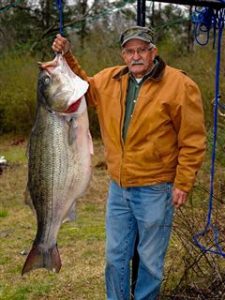World Record Striped Bass

After sharing this photo on Facebook it came to my attention that there are a decent number of people who are not very familiar with Striped Bass and how big they can get. I was shocked at how many people didn’t believe this was a real picture, with many people claiming it was a photoshop creation. I guess it would be easy to believe that it is fake if you are not familiar with Striped Bass. The catch really did happen, the fish is real, and it’s huge weighing in at 69 lb 9 oz. We linked to the official World Record Striped Bass HERE at The IGFA.
The New World Record Holder
This World Record Striped Bass (Landlocked) was caught by a gentleman by the name of James R. Bramlett (pictured above) in the Black Warrior River in Alabama on February 28, 2013. His catch beat the previous world record for landlocked striped bass by 2 lbs 1 oz which was 67 lb 8 oz fish caught May 7, 1992, by Hank Ferguson in Los Banos, Calif. Keep in mind that this is a “Landlocked” record from freshwater. Bigger Striped Bass have been caught in coastal waters.
Saltwater World Record Striped Bass

The King of Stripers was caught at Long Island Sound, Westbrook, Connecticut by Gregory Myerson on August 4, 2011. It nudged out its freshwater family member by 12 lbs 5 oz weighing in at 81 lb 14 oz. You can see the official record at the International Game Fish Association by CLICKING HERE.
More About Striped Bass

(Walbaum, 1792); MORONIDAE FAMILY; also called striper, rock, rockfish, squid hound, greenheadThe striped bass, or rockfish as it is known in North and South Carolina, occurs from the St. Lawrence River to northern Florida on the Atlantic coast of the United States; off Florida, Louisiana, Alabama and Mississippi in the Gulf of Mexico; and along the U.S. Pacific coast from Washington to California. Striped bass were unknown on the Pacific coast until they were introduced there in 1879 and 1882. On the east coast they have been well known to saltwater anglers and one of the most important food fishes since at least the early 1600’s. In saltwater, the striped bass is anadromous and migratory. Some migrate from North Carolina, Virginia, or Maryland to more northern climates in the summer and return when the summer season is over. Others remain non migratory within estuarine river systems such as the St. Lawrence, the Santee Cooper, or the Savannah. To most freshwater anglers, this very important game fish is relatively new. The species moves far upstream in rivers during spawning migrations. It has a native range (in freshwater) from the St. Lawrence River, N.Y., south to St. John’s River, Florida, and also from the Suwannee River in Florida, to Lake Pontchartrain in Louisiana. In some of these waters populations have become landlocked due to artificial impoundments that blocked their return to the sea. In recent years, striped bass have been introduced into freshwater systems in most of the states.The striped bass’ closest freshwater relatives are the white bass (Morone chrysops), the yellow bass (M. mississippiensis), and the white perch (M. americana). The striped bass is easily recognized by the 7 or 8 prominent black stripes that run along the scale rows on each side of its long, sleek, silvery body. One stripe runs along the lateral line, and the remainder are about equally divided above and below it. The first dorsal fin has 8 10 spines and the second, 10 13 soft rays. The anal fin has 3 spines followed by 7 13 soft rays. The dorsal fins are completely separated. The striped bass is longer and sleeker and has a larger head than its close and similar looking relative, the white bass. The striped and white basses have been crossed to create a hybrid known as the whiterock or sunshine (in Florida) bass. Striped bass can be distinguished from hybrids by the regularity of stripes while the hybrid usually has interrupted or broken stripes. A voracious and opportunistic predator, the striped bass will consume all types of fishes. A wide variety of fishing methods are successfully employed, including trolling, jigging, bait fishing, surf casting, fly fishing, and spinning. Baits and lures include mullet, squid, eels, crabs, clams, bloodworms, plugs, spoons, flies, and casting lures.
See full story on igfa.org
